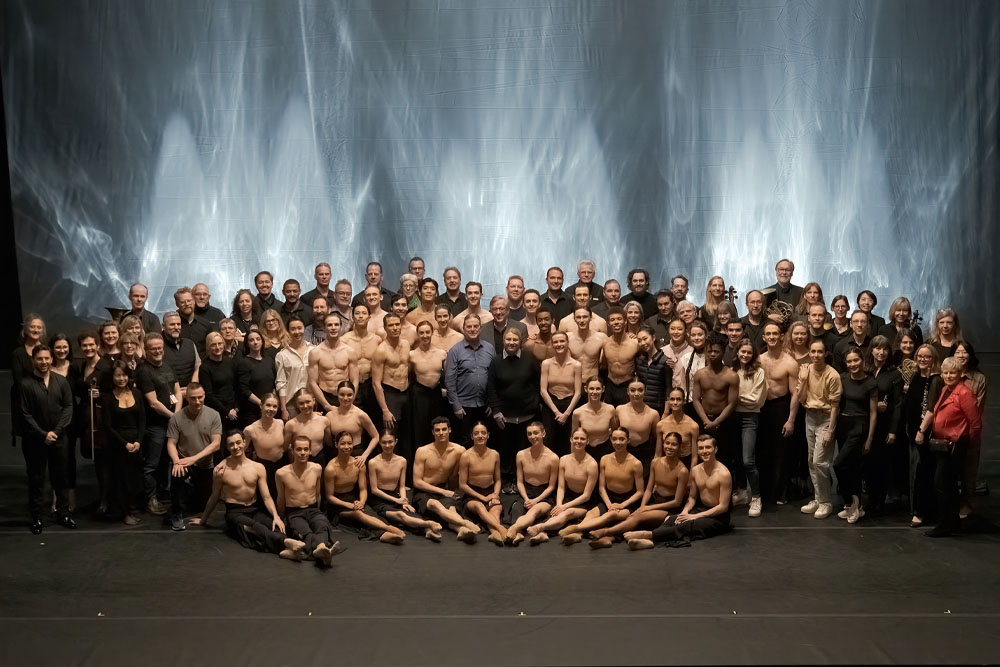Celebrating 10 Years With Executive Director Barry Hughson
by Caroline Dickie
January 18, 2024

Barry Hughson. Photo by Karolina Kuras.
Barry Hughson joined The National Ballet of Canada as Executive Director 10 years ago, in January 2014. During his tenure, he has worked alongside two Artistic Directors – Karen Kain and now Hope Muir – to guide the organization through periods of extraordinary growth and one of the greatest challenges in recent history, the COVID-19 pandemic. In celebration of Barry’s 10th anniversary, we invited him to reflect on his journey with the National Ballet and the passion for dance that has shaped his career.
What was you first experience with ballet and how has your relationship with it changed over the years?
I was a fairly clumsy kid so my mother signed me up for “acrobatics” classes, as it was called at the time. My sister was taking ballet at the same local school and I would wait for her class to finish and walk her home. Eventually the ballet teacher invited me to give it a try. But actually, the transformational moment didn’t have anything to do with ballet. I was involved in a school musical at the historic Palace Theater in Waterbury, Connecticut. Everything about that magnificent building was magical to me as a little kid. That was the beginning of my falling in love with the arts. My passion for ballet evolved over time. Once I started a serious training programme, dance became a way of life and it has been ever since.
What led you to The National Ballet of Canada?
An injury caused me to retire from dancing with The Washington Ballet in my early 20s. I went home to Connecticut to help my mom care for my father, who had just been diagnosed with cancer. During that time, I became involved with a local theatre group where I built a community school for the arts over a five-year period and then led the organization for an additional six years as Executive Director. That’s where I cut my teeth as an arts administrator. From there, I wanted to apply everything I’d learned to ballet. I became the first Executive Director of Complexions Contemporary Ballet, followed by American Repertory Ballet, Atlanta Ballet and finally Boston Ballet – an incredible experience in a fantastic city close to home. I wasn’t looking for a new opportunity. But when I got a call from a recruiter looking for the next Executive Director of The National Ballet of Canada, I decided to have that first conversation. I didn’t have any expectations going in but I ended up being very moved by the Directors and the passion of the search committee. The pivotal moment was my private dinner with Karen Kain, whom I admired and remembered watching as a teenager. Fifteen minutes into that dinner, I knew this was the person I wanted to work with – her generosity of spirit and her humility, her kindness and passion for this company, her transparency about the challenges and, most important to me, her desire to have a true partnership in leading the organization forward. We built an amazing partnership for almost eight years.
What does the role of Executive Director entail?
We have a co-leadership model that does not have the Executive and Artistic Directors operating in separate lanes. Co-leadership is two circles that intersect and at that intersection are the most important aspects of guiding an institution of this scale, such as culture, brand and strategy. Within that space, there’s quite a bit of consensus-building or bringing people along to a shared sense of vision, direction and values. I don’t see our work in a hierarchical way. There is real collaboration and partnership within our organizational structure. I think of my direct reports as my partners in leading the organization.
How has the company changed over the last 10 years?
When I first arrived there was some rigidity in terms of believing there is only one way to do things because that’s the way it’s always been done. I have a great deal of respect for systems and practices that have been built over time, because there’s often really important learning behind them. But I also think we have to be adaptable and ready to evolve with the world around us. It took time for people to embrace that spirit of adaptability. The fact that we got through the pandemic as well as we did is because we had built that adaptive muscle before we went into it. The pandemic was the ultimate test of our ability to pivot without denigrating the art form, the quality of our work or our reputation. You can be adaptive and still be excellent at what you do.
When I was hired, Karen had a very bold commissioning programme and the Board wanted to see the company re-entering the international dance conversation. So, we worked really hard over 10 years to elevate the brand internationally, touring to destinations like Paris, London, Hamburg and New York City and attracting top talent to our dancer roster. We’ve built a robust fundraising programme, audiences are returning to us post-pandemic and our Endowment Foundation has grown significantly, now sitting at more than $100M. We’ve also maintained a fiscal discipline that has allowed for a cumulative surplus over that 10 year period. We are one of few companies in North America who can say that, if not the only one.

Company on Stage at New York City Centre. Photo by Karolina Kuras.
How would you describe Hope Muir’s artistic vision?
When we interviewed candidates for the role of Artistic Director, we made it clear that we were looking for evolution, not revolution. Hope has embraced that while also having lots of ideas about programming. She wants to see choreographic opportunities spread more widely and distinctly than the handful of creators who now receive the bulk of the work at major dance companies. She wants to do things that will be unique to the National Ballet. One of the things I’ve really respected and appreciated about Hope is her complete commitment to the preservation of the classical ballet canon. Even though she has a strong contemporary background, Hope has put classical work front and centre in her programming. I think she will be a consequential Artistic Director.
What does an ideal future for The National Ballet of Canada look like? Could you share some of your immediate goals?
We’ve been leaning into embedding the values of Equity, Diversity and Inclusion across everything we do. We live in one of the most racially diverse cities in the world and our work and audiences should reflect this. We must continue to build trust and relevance across a really broad community. The Four Seasons Centre can’t be the only place where we share what we do. We have to go into our communities and find unique ways to reach our audiences. We also want to consider our national mandate – how do we live that? Perhaps that looks like multiple smaller tours to venues that can’t support full-length ballets but could offer a special curated programme. How can we leverage digital platforms to improve access? These are some of the questions we’re asking.
There are challenges ahead – we have cost structures that are growing faster than our ability to generate new revenue and a philanthropic culture that’s changing. But at the end of the day, I come to work because I was a young dancer once and someone did what I do to make possible the career that I had. On the tough days, that’s what motivates me. And with the state of the world right now, the arts are essential to lifting people up and bringing them joy and a sense of hope and optimism that otherwise can feel in short supply. That’s why we do this every day.